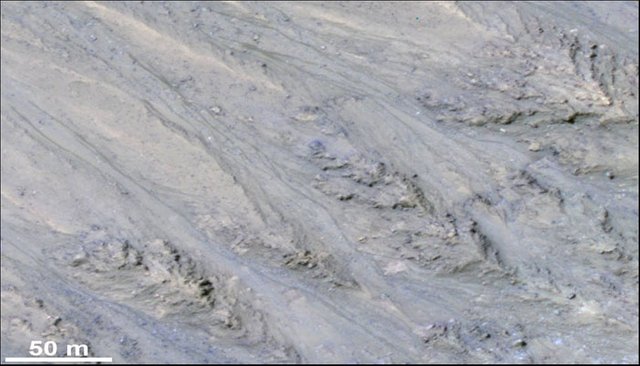
The study is based on observations made with the High-Resolution Imaging Science Experiment (HiRISE) camera on NASA's Mars Reconnaissance Orbiter.
The Red Planet is full of surprises and scientists are leaving no stone unturned to discover its secrets.
While water on Mars was one of the most biggest discoveries in the field of space, a study has revealed that the dark features earlier proposed as evidence of liquid water flowing on the Red Planet may actually be granular flows, where sand and dust move rather than liquid water.
These findings indicate that it is difficult for Earth-like life to exist near the surface of Mars owing to the water-restricted conditions that exist on the planet.
The study is based on observations made with the High Resolution Imaging Science Experiment (HiRISE) camera on NASA's Mars Reconnaissance Orbiter (MRO).
The researchers analysed narrow, down-slope trending surface features on Mars that are darker than their surroundings, called Recurring Slope Lineae, or RSL.
These features have evoked fascination and controversy since their 2011 discovery, as possible markers for unexpected liquid water or brine on an otherwise dry planet.
These RSL features grow incrementally, fade when inactive and recur annually during the warmest time of the year on Mars.
RSL are mostly found on steep rocky slopes in the dark regions of Mars, such as the southern mid-latitudes, Valles Marineris near the equator and in Acidalia Planitia on the northern plains.
The appearance and growth of these features resemble seeping liquid water, but how they form remains unclear, and this research demonstrated that the RSL flows seen by HiRISE are likely moving granular material like sand and dust.
"We've thought of RSL as possible liquid water flows, but the slopes are more like what we expect for dry sand," said lead author Colin Dundas, a US Geological Survey scientist.
"This new understanding of RSL supports other evidence that shows that Mars today is very dry," Dundas added.
The terminal end of the RSL slopes, said Dundas, are identical to the slopes of sand dunes where movement is caused by dry granular flows.
Water almost certainly is not responsible for this behaviour, which would require the volume of liquid to correspond to the length of slope available, producing more liquid on longer slopes, the study said.
Hi! I am a robot. I just upvoted you! I found similar content that readers might be interested in:
https://in.news.yahoo.com/flowing-water-mars-may-sand-dust-study-130203703.html
Downvoting a post can decrease pending rewards and make it less visible. Common reasons:
Submit